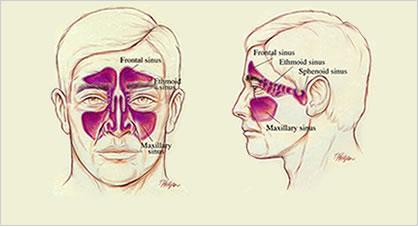Chronic sinusitis, or chronic rhinosinusitis, is a very common medical illness that is defined as sinus inflammation that lasts three or more months. It is different than acute sinusitis, which involves sinus inflammation for less than four weeks.
The illness affects men and women equally, as well as both pediatric and adult patients. It is estimated that over 30 million patients in the U.S. alone suffer from chronic sinusitis. It is one of the most common reasons patients are prescribed antibiotics.
The pathophysiology is not well understood, but research is ongoing to better understand the disease process. Currently, we believe the ostiomeatal complex (an important site where the majority of the sinus cavities drain into the nasal passages) becomes obstructed. The obstruction can be mechanical, from a septal deviation or polyp, or from membrane swelling, most commonly from allergies or a viral respiratory infection. This obstruction then leads to stasis of mucous, which is a good median for bacterial growth, and acute sinusitis develops. With persistence of the infection, mixed flora, anaerobic organisms, and, occasionally, funguscontribute to the pathogenesis. Most cases of chronic sinusitis are due to acute sinusitis that either is untreated or does not respond to treatment. Rarely, other forms of sinusitis occur, such as a fungal infection or an infection secondary to a dental infection.
The symptoms of chronic sinusitis are different than acute sinusitis, as facial pain and fever are usually absent with the chronic disease. The most common symptoms include nasal congestion with posterior nasal drainage, periorbital pressure or headache, bad breath with unpleasant taste, nonproductive cough, and malaise.
The physical exam performed by a physician is often limited as the sinus cavities can not be directly visualized. An ENT physician often will look further into the nasal cavities with a telescope in attempt to see where the sinuses drain and to ensure no polyps or tumors are noted. However, to better visualize the sinuses, radiographic studies, and a CT scan is the gold standard, are needed.
Other laboratory studies, such as blood work, are often not needed. Occasionally, physicians need to rule-out any immune disease disorder or other connective tissue disease, both of which are rare. However, it has been well documented that allergic rhinitis is commonly associated with chronic sinusitis, and that allergy testing may be performed.
Once the diagnosis of chronic sinusitis is made, then physicians will first treat with aggressive medical management. This typically includes a 4 to 6 week course of broad-spectrum antibiotics, such as Augmentin or Levaquin. Other important adjunctive treatments include steroids, nasal and/or systemic decongestants, mucolytics, intranasal steroid spray, and sinonasal saline rinses. If symptoms do not resolve, then surgical procedures then are indicated.
The surgical management of chronic sinus disease has gone through many changes over the past few years. Currently, in nearly all cases, surgery is performed with telescopes (endoscopes), known as endoscopic sinus surgery (ESS). This allows the sinuses to be opened and drained without using any external incisions. The surgical procedure often takes 2-3 hours to be performed, using general anesthesia. A newer technology, known as image-guidance where a computer is used to help guide surgery, is often used if patients have polyps or require additional surgery. Overall, the success rate of the surgery is noted to be 80-90% based on the latest research.
Following surgery, patients may have packing placed in the nose and sinuses (often dissolvable packing can be used). This is to reduce the rate of bleeding after surgery, which can occur in 2-4 percent of patients. Patients will need to avoid heavy lifting or exercising for 2 weeks following surgery to reduce the chance of bleeding. It is imperative for healing that patients keep their nose moist after surgery, using saline sprays and steaming (vaporizing) multiple times during the day. If infection or polyps are noted during surgery, then patients will need antibiotics and steroids continued after surgery. All of these measures are to increase the chance of complete resolution of the chronic sinus disease.
A new procedure, one that is an alternative to traditional sinus surgery, is now available for patients with chronic sinusitis. The balloon sinoplasty technique is a less invasive procedure, with a lower risk of bleeding and pain. Many patients can have this done in an office setting with no general anesthesia. After applying topical and local anesthesia, a telescope is introduced just as in traditional sinus surgery, but a balloon is inserted into the opening of the sinus cavity and then dilated to further open the cavity. The overall time for the procedure is usually around an hour. Studies are showing over 90% patency rates for the dilated sinus openings following the balloon procedure, indicating very good patient responses. However, not all patients may have benefit from this procedure, such as patients with polyps or narrowed nasal cavities.
It is important for patients with chronic sinusitis to understand that this is a chronic disease that often requires long-term treatments and behavioral changes. Many patients need continued allergy treatments following the sinus management. One of the most important behavioral changes is tobacco smoke cessation. Patients that continue to smoke following sinus treatments dramatically reduce their long-term chance of a successful outcome.
Persistent or recurrent episodes of sinusitis despite appropriate medical therapy necessitate referral to an otolaryngologist. Examination, including nasal endoscopy and CT scanning, is required to make a diagnosis of chronic sinusitis. There are both medical and surgical treatments that offer a good prognosis for healing. Any questions or concerns can be further discussed with your local ENT physician.
Robert Wilson, MD.

